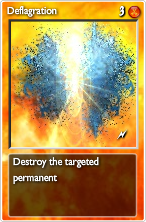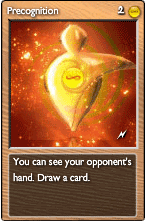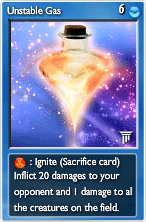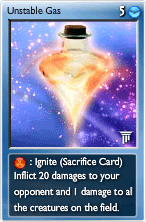Unstable Gas
|
|
Contents
Overview
As the only permanent that can deal damage to every enemy (and ally) creature on the field and the opposing player at the same time, Unstable Gas (also known as ‘UG’) is a one-use alchemy card that will deal 20 damage to the enemy player and 1 damage to all targetable creatures on the field. It is also the only "alchemy card" that works as a permanent as opposed to spell.
General Use
Quick Facts:
- Unstable Gas deals 20 spell damage (can be reflected) to the opposing player upon the 'Ignite' ability being triggered.
- Also deals 1 damage to all targetable creatures on the field (including ally creatures).
- Must trigger the 'Ignite' ability in order to set off the damage - removing the Unstable Gas via other permanent control will not set it off.
While the majority of player-targeted cards are spells ( Lightning, Fire Bolt, etc.), Unstable Gas is a unique one in that it also simultaneously targets all creatures on the field at the same time. For 6 (5 upgraded) ![]() quanta, players can play the Unstable Gas on the field, then use 1
quanta, players can play the Unstable Gas on the field, then use 1 ![]() quanta to Ignite (or destroy) it to set off the damage. Destroying the card via other means (like Deflagration) will not trigger the Ignite ability. It’s important to note that Unstable Gas requires at least one turn to use its ability, acting as a pseudo-‘bomb’ for the Air element.
quanta to Ignite (or destroy) it to set off the damage. Destroying the card via other means (like Deflagration) will not trigger the Ignite ability. It’s important to note that Unstable Gas requires at least one turn to use its ability, acting as a pseudo-‘bomb’ for the Air element.
What players should remember is that the damage from Unstable Gas can stack quickly; multiple Unstable Gases played onto the field in the same turn can be a literal OHKO (one-hit KO) the following turn if the opposing player has no means to stop or suppress the incoming damage. For 20 damage a pop, 5 Unstable Gases can take any regular enemy from 100 HP to zilch given the right amount of ![]() quanta if detonated back-to-back. Of course, such a setup can be difficult to pull off due to various PC like Steal and Deflagration, but careful planning and card combos can make this strategy viable against stall decks or ones with intensive healing capabilities.
quanta if detonated back-to-back. Of course, such a setup can be difficult to pull off due to various PC like Steal and Deflagration, but careful planning and card combos can make this strategy viable against stall decks or ones with intensive healing capabilities.
Unstable Gas has some notable disadvantages compared to damage-dealing spells however. As a permanent, the 1 turn wait can give an opponent time to counter the UG with again, permanent control or healing effects. In addition, UG has no special bypass around reflective shields like Emerald Shield. A player can target his or her own reflective shield to bypass the opponent’s reflective shield with a spell such as Thunderbolt, but Unstable Gas only targets the opponent, making it a dead card. In addition, it also damages the player’s creatures as well as the enemy’s - frail critters with low HP might be killed or brought down to frail levels if multiple Unstable Gases are set off. Thus, players need to account for these small details to ensure that the Unstable Gases are used as effectively as possible.
Synergies
 Deflagration | Explosion can be potent in many UG decks that only include a Mark of Fire for the
Deflagration | Explosion can be potent in many UG decks that only include a Mark of Fire for the ![]() quanta generation. Unless there are other Fire cards being used, the spell can be effective in getting rid of weapons or other troublesome permanents. In most cases, Deflagration can help use up some of the excess
quanta generation. Unless there are other Fire cards being used, the spell can be effective in getting rid of weapons or other troublesome permanents. In most cases, Deflagration can help use up some of the excess ![]() quanta a player would accumulate if they don’t get the Unstable Gases on the field early enough.
quanta a player would accumulate if they don’t get the Unstable Gases on the field early enough.
 In other cases, the speed in getting the UG cards out is the most important aspect. Precognition | Precognition is the cheapest Time card that can instantly speed up a deck while also providing the player insight on the enemy’s hand - in case the enemy has PC, a player can then choose to withhold their Gases or even bait the PC with a weapon so that their Gases remain untouched, all the while going through their deck to get the explosive punch in time. Although this card turns a deck into a trio, Precognitions are only worth 1-2
In other cases, the speed in getting the UG cards out is the most important aspect. Precognition | Precognition is the cheapest Time card that can instantly speed up a deck while also providing the player insight on the enemy’s hand - in case the enemy has PC, a player can then choose to withhold their Gases or even bait the PC with a weapon so that their Gases remain untouched, all the while going through their deck to get the explosive punch in time. Although this card turns a deck into a trio, Precognitions are only worth 1-2 ![]() quanta, and thus can be fueled by a few pillars or pendulums, or even the mark depending on the deck composition.
quanta, and thus can be fueled by a few pillars or pendulums, or even the mark depending on the deck composition.
 A spell for
A spell for ![]() burst, Immolation | Cremation sacrifices an ally creature to gain 6
burst, Immolation | Cremation sacrifices an ally creature to gain 6 ![]() , which is enough to trigger all Gases on a field and deal more than 100 damage all at once. In case one's Mark is not available for
, which is enough to trigger all Gases on a field and deal more than 100 damage all at once. In case one's Mark is not available for ![]() quanta generation, the elemental can just pack a couple of these, play the deck as usual, and Immolate one of their creatures in the end of the game to detonate all of the gases simultaneous for a grand OHKO.
quanta generation, the elemental can just pack a couple of these, play the deck as usual, and Immolate one of their creatures in the end of the game to detonate all of the gases simultaneous for a grand OHKO.
Other Cards With Synergy
The Elite Firefly can be a great way to merge the Air and Fire elements together, as it can easily produce ![]() quanta for the Ignite ability. Other cards, such as Quintessence or even Cloak, can help protect ally creatures from being hit by the explosion, or sacred permanents from being hit by Explosion. Other cheap or useful cards that can work well with the UG damage include Boneyard ( Skeleton fodder), Bone Wall, Minor Phoenix, and even Mirror Shield or Jade Shield, as the UG (if stolen) can’t be used against the player that owns them.
quanta for the Ignite ability. Other cards, such as Quintessence or even Cloak, can help protect ally creatures from being hit by the explosion, or sacred permanents from being hit by Explosion. Other cheap or useful cards that can work well with the UG damage include Boneyard ( Skeleton fodder), Bone Wall, Minor Phoenix, and even Mirror Shield or Jade Shield, as the UG (if stolen) can’t be used against the player that owns them.
Conclusion
For any player that enjoys the occasional boom in a deck, Unstable Gas is perfect to include for setting up the OHKO or even a quick burst of damage. However, the Blue Nymph would be the perfect gift for those who prefer to use a limitless amount of the volatile bottle, and serves a ongoing joke about the dangerousness of one’s expelled gases…
Popular Deck

6s3 6s3 6s3 6s3 6s3 7ac 7ac 7ac 7ac 7ac 7ac 7ac 7ac 7an 7an 7an 7an 7an 7mt 7mt 7mt 7mt 7mt 7mt 7n6 7n6 7n6 7n6 7n6 7n6 8po


